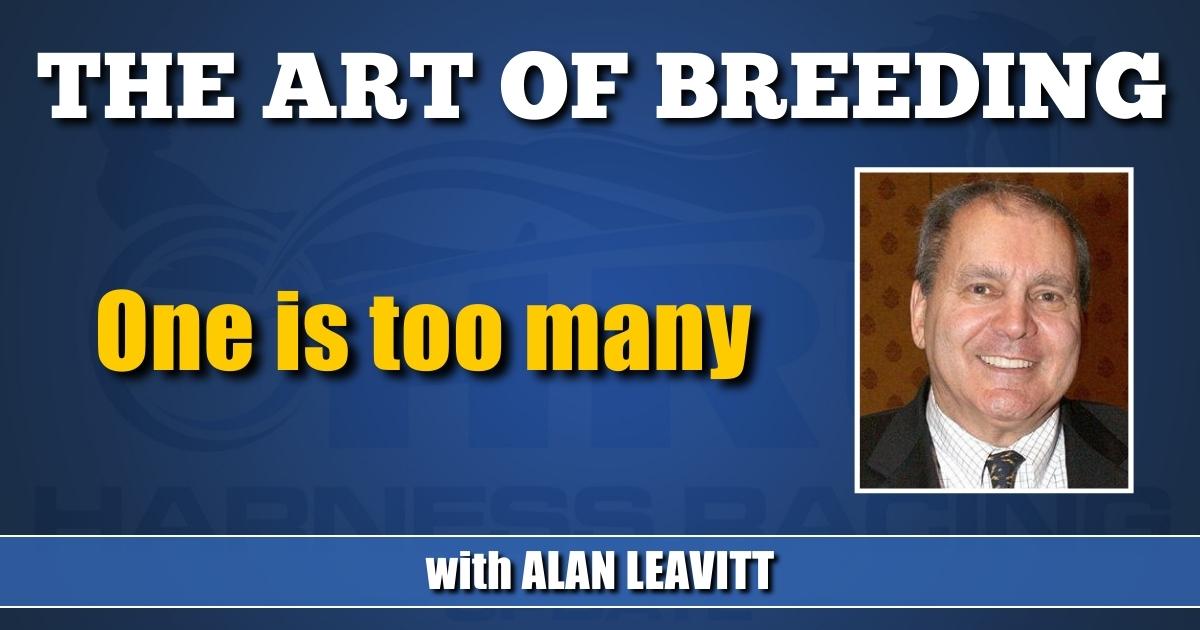One is too many
by Alan Leavitt
Writing in the April issue of Hoof Beats, Russell Williams does a workmanlike job of detailing the fatal flaws of the Horseracing Integrity and Safety Act, aka HISA.
Williams has been instrumental in having the USTA bring a lawsuit against HISA, and one can only hope it succeeds. Interestingly enough, for those of us living in Kentucky, the court where the battle will be fought happens to be in downtown Lexington.
It is understandable that HISA has been embraced by certain factions in our sport, having become totally frustrated by the failure of certain racing commissions to catch and punish dopers.
There is no question that being able to wiretap, as the FBI can, makes it much easier to catch the culprits who sell the “hot stuff,” and the trainers who use it. But any commission, including the one here in Kentucky, has another weapon that doesn’t require Federal action.
I’m talking about a snitch network, which doesn’t require rocket science to create. As a card carrying member of the Mystery Writers Guild of America, I could personally line up some snitches in no time flat. Of course, they would have to be “reimbursed,” but we’re not talking about any great sums of money.
What one can’t lose sight of here is the fact that someone has to load a syringe, someone has to slip a twitch on a horse’s nose, and someone has to depress the plunger on the syringe after sticking the needle in the horse’s neck. And there is someone who is either directly involved or aware of what’s going on, and for five hundred dollar bills will be happy to tell you about it.
Now to the horses, specifically the year-end champions of 2021. Both of the 2-year-old Dan Patch pacing champions were sired by Always B Miki, and both of the trotting champions were by Walner. Clearly each of those two stallions have a speed gene that, in a deck of cards would start with a 10, and go up from there.
In the case of the champion pacing filly, Niki Hill, her dam, Road Bet, is a mare with her own stacked genetic deck. From three foals of racing age, she’s already produced two world beaters, Niki Hill and Cattlewash. They’re by two different sires. To me, she’s a pearl beyond price, and I predict she’ll keep turning out fast horses who win big money.
The champion 2-year-old pacing colt, Monte Miki, is a different kettle of fish. His dam, Montenegro, was a top race mare, who won more than $699,000. (Although Road Bet also was good on the track, winning $380,315). M² is her first foal, and the only one by ABM. The next two are by more obscure studs, and it will be interesting to watch them on the track.
About both of these dams of champions, popular belief would say that they produced top horses because they themselves were top race horses. I beg to differ.
There is no known connection between a horse’s genotype, or genetic profile, and its phenotype, or living horse, i.e. the racehorse. In these two cases, two top race mares also happen to be blessed with high card speed genes. But I don’t think their ability on the track foreshadowed their production of champions.
Both of the 2-year-old trotting champions are also by the same sire, in this case Walner. Being bred by a Scandinavian, it’s a safe bet that Walner is named after Håkan Wallner, one of the first great Swedish horsemen to make his mark on American trotting. Operating as Continental Farm, Wallner had as his partners Jan Johnson and Berndt Lindstedt. They could pick yearlings, train them to their best, and drive competitively against our best native drivers. (I probably should say best North American drivers, because both John Campbell and Mike LaChance were Canadian-born).
The champion colt, King Of The North, is the fourth foal of Ray Schnittker’s great race filly Check Me Out, who won almost $2 million. Her first three foals were by good stallions, but not exceptional on the track. One has to wonder if Walner is on his way to being a super sire. I’ve learned you can’t make any final judgments from a horse’s first crop, although Walner gave me (and Federico Tesio) every indication he’d be a top sire by his undefeated campaign at two, where he was in a class by himself.
The champion 2-year-old trotting filly was Venerable, also by Walner, as noted, and out of Jolene Jolene. Here we have another mare who, from three foals of racing age has produced Venerable, who won over a million at two last year, and Crucial, who won over half a million. She could well be another mare with a stacked genetic deck, although I suspect she’ll be a regular in Walner’s book from now on.
For the record, looking up the names of Steve Stewart’s partners who bred Venerable with him, I counted a total of six Schmuckers. Obviously thar’s gold in them thar Indiana hills.
Thinking back to what I wrote earlier about the role of snitches, I’m reminded of a true Kentucky story from long ago.
There was a guy here in the bluegrass state who owned one good mare, and to his despair she foaled before midnight on New Year’s Eve.
The next morning he and his total staff of one were standing in the stall door, looking over the mare and her new foal.
“What terrible luck,” the owner was moaning. “I was counting on that foal to make the next mortgage payment. And now he’s practically worthless.”
“Boss,” the hired man said, “Why can’t you just say he was born after midnight?”
“I can’t,” the owner said. “Too many people know.”
“What do you mean, too many people know? It’s just you and me.”
“That’s what I mean,” the owner answered, as he walked back to his car.

















